Intel Core i7 4960X (Ivy Bridge E) Review
by Anand Lal Shimpi on September 3, 2013 4:10 AM EST- Posted in
- CPUs
- Intel
- Ivy Bridge
- Ivy Bridge-E
Memory Performance
Seeing as how the huge L3 cache and quad-channel memory interface are big parts of what makes Ivy Bridge E unique, I thought it might make sense to look at memory latency and bandwidth. We'll start with memory latency, compared to Ivy Bridge, Haswell and Haswell + Crystalwell.
The larger L3 cache buys IVB-E lower latency accesses for a wider range of addresses, but once you exceed the 15MB L3 cache space we see latency about on par with everything else. Only Haswell + Crystalwell manages to hold out for longer. Unfortunately that's not really a part desktop enthusiasts can buy so it's mostly an academic comparison.
The bandwidth story is an interesting one. Sandra maxes out bandwidth by driving all cores at the same time, so you get some uplift here by there simply being more cores under IVB-E's hood. But even if you divide out the number of cores, you get per core cache bandwidth figures that are extremely high (at least outside of L1). The L3 cache in particular is quite bandwidth happy.
Going outside of the L3 cache, we also see a doubling of memory bandwidth - which is expected given the doubling of memory interface width. In reality the peak memory bandwidth advantage would be even larger as IVB-E officially supports DDR3-1866 (if you only populate 1 DIMM per channel, otherwise either 1333 or 1600 is officially supported).
General Performance
I don't know that I've ever seen an Intel slide before that called out a performance degradation, but there's a first time for everything:
The problem with IVB-E vs. Haswell is that the extra large L3 cache and quad-channel memory interface are generally only useful in heavily threaded applications, which of course benefit from its 6-core configuration. In those tests that aren't heavily threaded however, IVB-E typically sees a single threaded performance deficit compared to Haswell. Given that the 4960X and Haswell based Core i7-4770K run at very similar frequencies, it's not surprising to see IVB-E take a backseat to Haswell in in "everyday computing" tasks. Intel's slide above claims about a 18% reduction in "everyday computing" performance compared to the 4770K, but in practice I found the gap to be much narrower.
Although not the best indication of overall system performance, the SYSMark 2012 suite does give us a good idea of lighter workloads than we're used to testing.
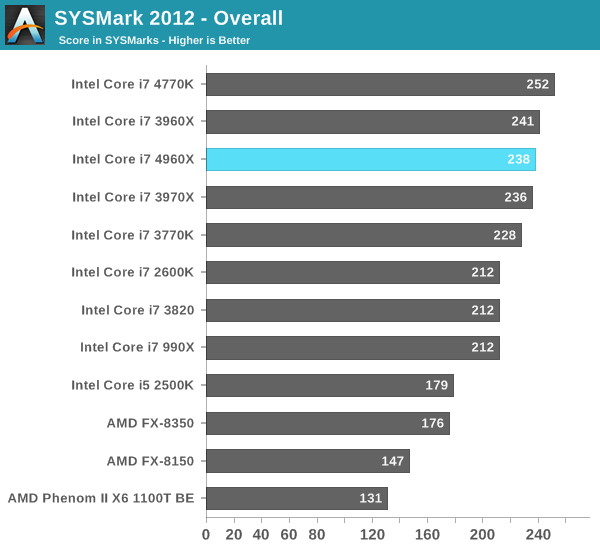
There's pretty much no advantage to the 4960X over the 3970X here. Remember Ivy Bridge's architectural improvements were very limited on the CPU side. As clock speeds didn't really go up between the 3970X and 4960X, the performance parity here isn't surprising. Haswell manages a ~6% performance advantage over the 4960X at an obviously lower power and price point.
Although I retired SYSMark 2007 a while ago, I do have much older performance data here which lets us compare the 4960X back as far as the early Pentium 4 based Extreme Edition parts:
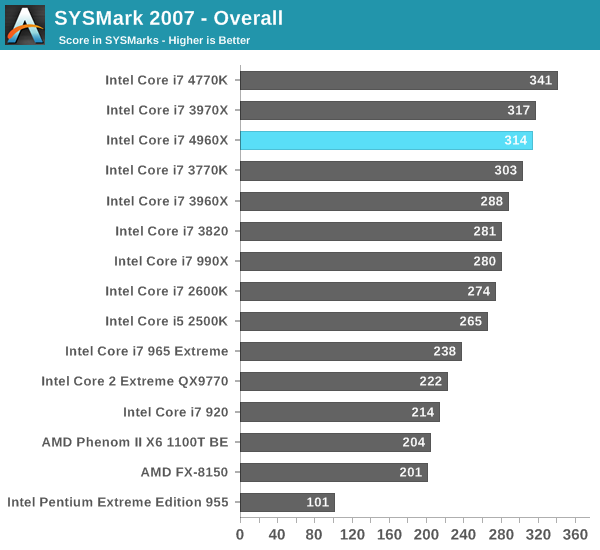
The Haswell advantage grows a bit here to around 8%, but the 4960X remains in the top three performers here. It's very clear that for most users, there are far more cost effective ways of getting great performance than IVB-E.
Our final lightly threaded test is Mozilla's Kraken JavaScript benchmark. This test includes some forward looking js code designed to showcase performance of future rich web applications on today's software and hardware. We run the test under IE10:
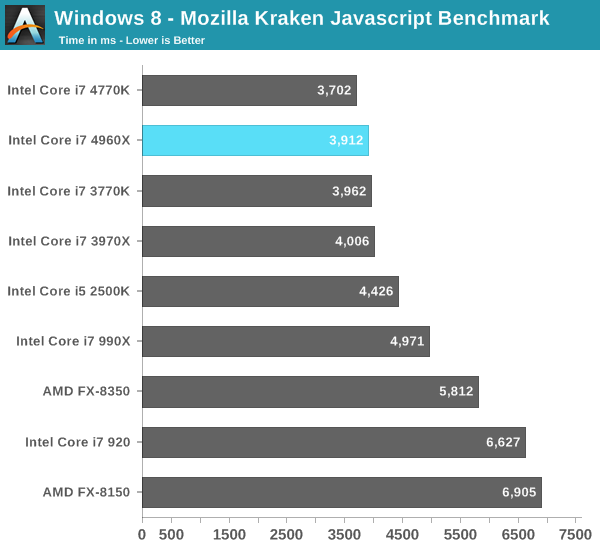
Ivy Bridge always had good single threaded performance, but once again these lightly threaded use cases are better served by an architecture with higher IPC. The Haswell advantage isn't huge, but it's a lower power/more cost effective way to get the best performance here.
If you are still on LGA-1366, you'll note that the performance gains here are good, but not earth shattering. Comparing to Intel's first 6-core platform, the 4960X manages a 27% increase in performance over the Core i7-990X. That's a healthy gain, but it's still small enough where there's no immediate need to upgrade.


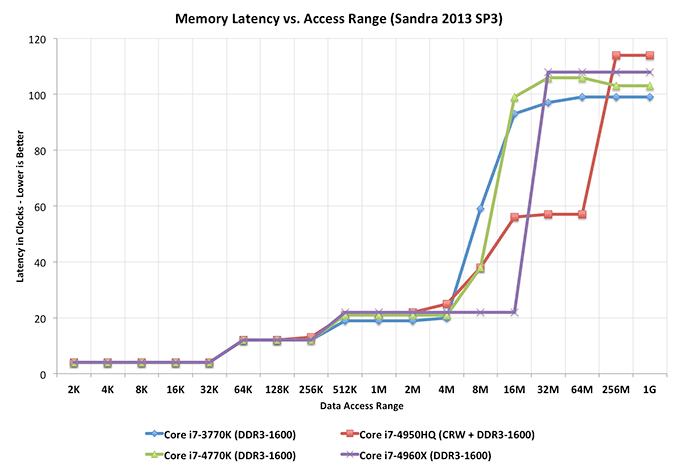
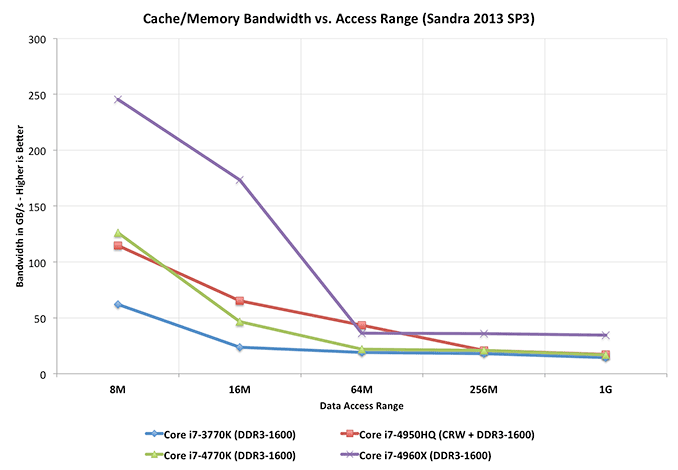
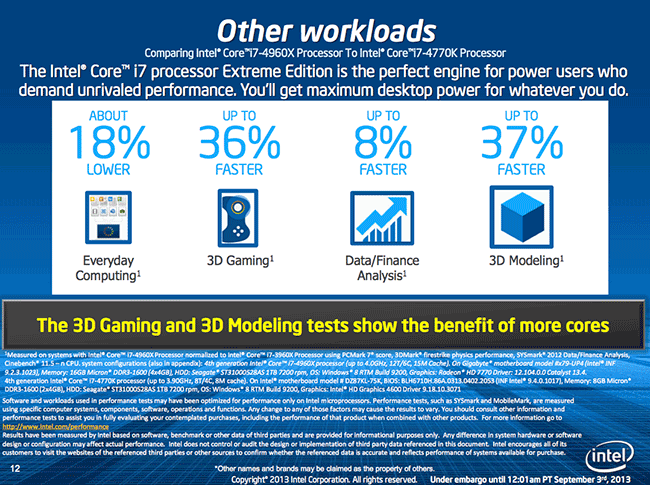








120 Comments
View All Comments
cactusdog - Tuesday, September 3, 2013 - link
IB-E is a massive failure just like SB-E. Thanks Intel for killing the highend for me. Actually, I think this is their plan, to kill the highend. Its ridiculous that this platform is so far behind the mainstream platform. 2x sata 6GB/s ports? No Intel USB 3.0? Worse Single threaded performance than mainstream? Sandy Bridge-e seemed like an unfinished project where many compromises were made and ivy-e looks the same.knweiss - Tuesday, September 3, 2013 - link
Anand, you write that Corsair supplied 4x 8GB DDR3-1866 Vengeance Pro memory for the testbed. However, you also remark "infrequent instability at stock voltages" with 32 GB. Then, in the legend of memory latency chart, you write "Core i7-4960X (DDR3-1600)" .So I wonder which memory configuration was actually used during the benchmarks? Less than 32 GB with DDR3-1866, non-stock voltages, or 32GB DDR3-1600? Wouldn't anything but 4x DDR3-1866 be a little bit unfair because you otherwise don't utilise the full potential of the CPU?
bobbozzo - Tuesday, September 3, 2013 - link
The article says that 1600 is the max memory speed SUPPORTED if you use more than one DIMM per channel.knweiss - Wednesday, September 4, 2013 - link
There are 4 channels.chizow - Tuesday, September 3, 2013 - link
Nice job Anand, your conclusion pretty much nailed it as to why LGA2011 doesn't cut it today and why this release is pretty ho-hum in general. I would've liked to have seen some 4820K results in there to better illustrate the difference between 4770K Haswell and SB-E, but I suppose that is limited by what review samples you received.But yeah, unless you need the 2 extra cores or need double DIMM capacity, there's not much reason to go LGA2011/IVB-E over Haswell at this point. Even the PCIe lane benefit is hit or miss for Nvidia users, as PCIe 3.0 is not officially supported for Nvidia cards and their reg hack is hit or miss on some boards still.
The downsides of LGA2011 vs LGA1150 are much greater, imo, as you lose 4 extra SATA3(6G) ports and native USB 3.0 as you covered, along with much lower overall platform power consumption. The SATA3 situation is probably the worst though, as 2 isn't really enough to do much, but 6 opens up the possibility of an SSD boot drive along with a few really fast SATA3 RAID0 arrays.
TEAMSWITCHER - Tuesday, September 3, 2013 - link
I'm really disappointed by these numbers. As a software developer, the FireFox compile benchmark best indicates the benefit I would get from upgrading to this CPU. And, it looks like the 4770K would be about the same difference - except far less expensive. I really don't think I need anything more than 16GB for RAM, and one high-end graphics card is enough to drive my single WQHD (2560x1440) display. Do bragging rights count? No...I mean really?madmilk - Tuesday, September 3, 2013 - link
Time to consider Xeons...MrBungle123 - Tuesday, September 3, 2013 - link
What's a Xeon going to do? Be slower than the 4960X? You lose clock speed by going with huge core counts and that translates to even more losses in single threaded performance. There comes a point where there are diminishing returns on adding more cores... (see AMD)MrSpadge - Tuesday, September 3, 2013 - link
Time to save yourself some money with a 4770 - not the worst news.Kevin G - Wednesday, September 4, 2013 - link
Your best bet would be to hope for desktop CrystalWell part. That extra cache should do wonders for compile times even if you'd lose a bit of clock speed. However, Intel is intentionally holding back the best socket 1150 parts they could offer as the benefits of Crystalwell + TSX optimized software would put performance into large core count Xeon territory in some cases.